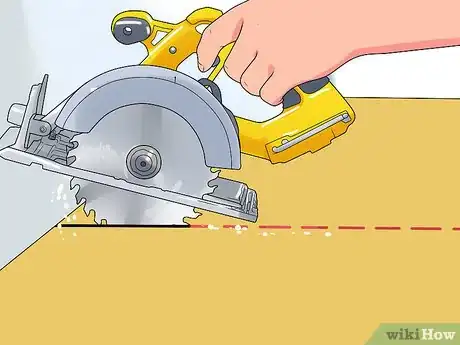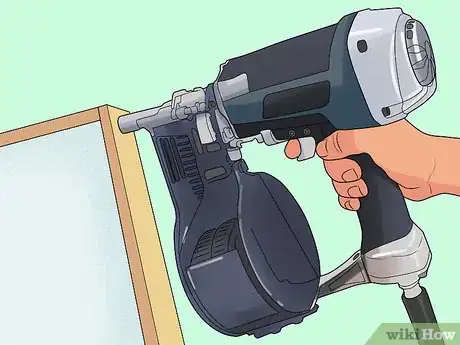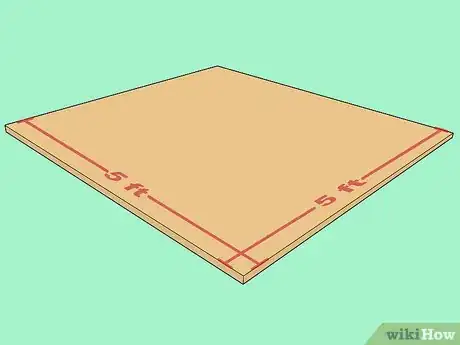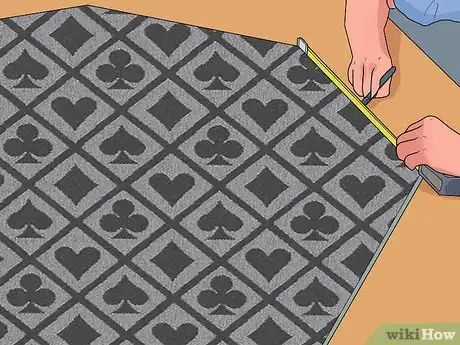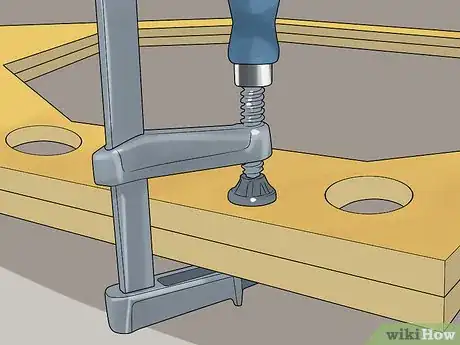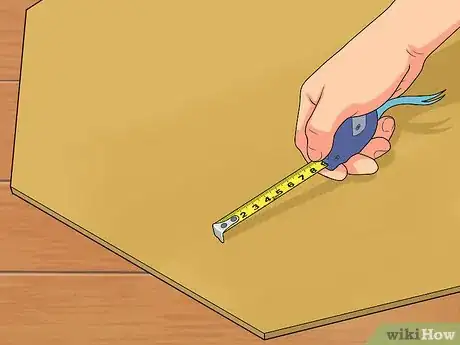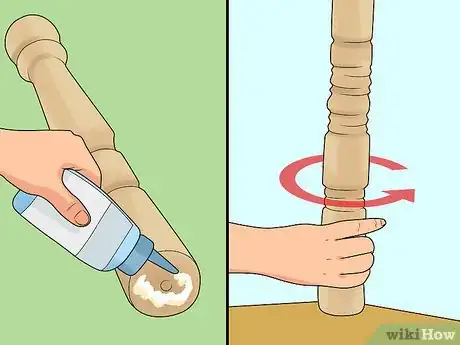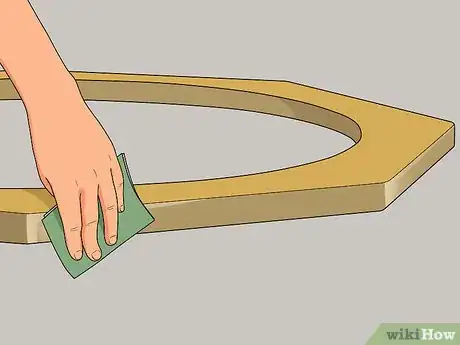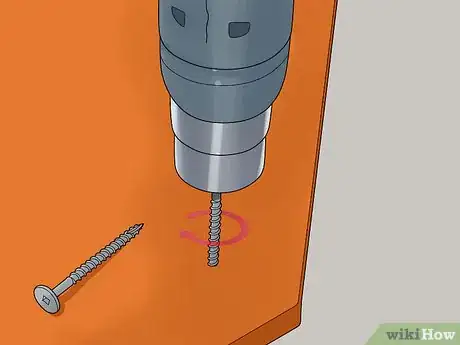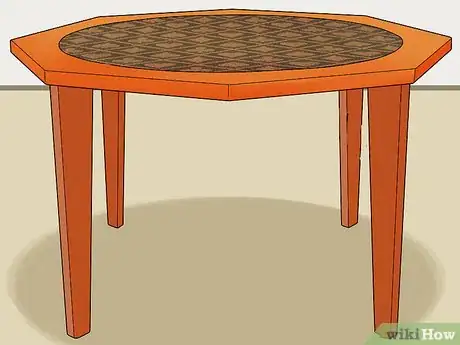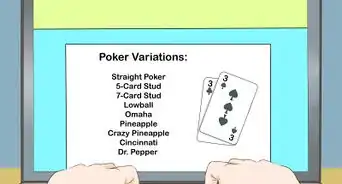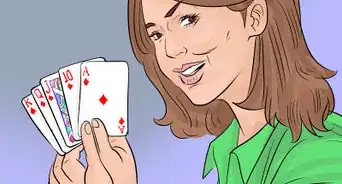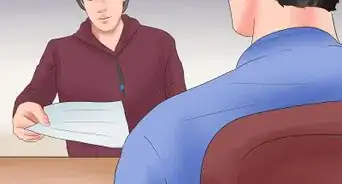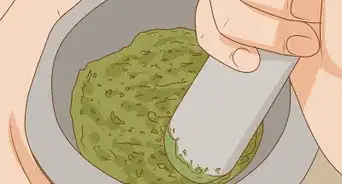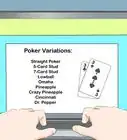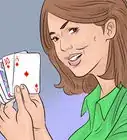This article was co-authored by wikiHow staff writer, Eric McClure. Eric McClure is an editing fellow at wikiHow where he has been editing, researching, and creating content since 2019. A former educator and poet, his work has appeared in Carcinogenic Poetry, Shot Glass Journal, Prairie Margins, and The Rusty Nail. His digital chapbook, The Internet, was also published in TL;DR Magazine. He was the winner of the Paul Carroll award for outstanding achievement in creative writing in 2014, and he was a featured reader at the Poetry Foundation’s Open Door Reading Series in 2015. Eric holds a BA in English from the University of Illinois at Chicago, and an MEd in secondary education from DePaul University.
There are 18 references cited in this article, which can be found at the bottom of the page.
This article has been viewed 30,439 times.
Learn more...
A professional fabric-lined poker table is the perfect way to get your friends excited for poker night. Since good poker tables can be hard to find and expensive to ship, you may want to consider building your own. By constructing a homemade poker table, you will ensure that it fits comfortably in your home and meets your specific needs. If you’re going to build a poker table though, you should have an open and well-ventilated area to work and at least a basic understanding of how to operate power tools.
Steps
Building Your Playing Surface
-
1Measure corners on a 4 by 4 feet (1.2 by 1.2 m) sheet of plywood. Use a straight edge ruler to measure 14 inches (36 cm) from the corner of your plywood along the side. Make one mark vertically, and then one mark horizontally, and use your ruler to connect the two marks and draw a line. Do this for each of the 4 corners on your sheet of plywood to make an octagon.[1]
- You can also use a permanent marker, white chalk, or a grease pencil to mark your lines.
-
2Use a circular saw to cut the corners of your table top. Lay your plywood flat on a work bench or flat surface and secure it with clamps. Line the guiding line of your circular saw up with each pencil mark and pull the saw’s trigger. Let the saw carry itself through your line and don’t push while the saw is firing.[2]
- Always wear protective eyewear when using power tools.
- Keep both hands on the two handles on top of your circular saw while the trigger is firing. You can use a jigsaw if you’re more comfortable with it.
- Your plywood sheet will be in the shape of an octagon after you’ve finished cutting each corner.
Advertisement -
3Spray adhesive on your plywood and add your 1⁄4 inch (0.64 cm) foam. In a well-ventilated area, cover the entirety of your plywood with a heavy-duty adhesive spray.[3] Roll your foam across the top of the plywood, smoothing it with your free hand as you place it down. Weigh your foam down for an hour by placing any heavy, flat objects across the entirety of the surface.[4]
- If you don’t spray every section of your plywood with adhesive, you could end up with air bubbles in your playing surface.
- You can purchase heavy-duty adhesive glue at your local hardware store. Double-check the can to make sure that your adhesive works with wood before purchasing and using it.
Tip: If you have someone who can help you, lay the foam out flat by placing it upside down and dropping the glued surface on top instead.[5]
-
4Use a utility knife to cut the excess foam off of the table. After the foam has dried, use a utility knife to shave any excess foam off by pulling on the edge with your nondominant hand while cutting carefully. Scrape your knife against each edge of your table to ensure that the foam is flush with the plywood.[6]
- Place something heavy in the center of your table while you remove the excess foam. In the off-chance that the foam hasn’t fully dried, it could end up sliding while you’re cutting it.[7]
-
5Install pine trim along the edge with a nail gun or drill. Use pine trim between 1⁄4 inch (0.64 cm) and 1 inch (2.5 cm). Measure each piece to match each edge of your plywood octagon and mark your cuts with a pencil or white chalk. Use a circular saw or jigsaw to cut your pieces and affix them to the plywood with a nail gun or drill.[8]
- The width of your trim will dictate the size of the lip between your playing surface and the table itself.
-
6Spray your tabletop with adhesive and add the speed cloth. Place your speed cloth playing-side down on a flat surface. Spray each section of the speed cloth’s underside with your adhesive. Lift your playing surface up, and gently lower it, playing-side down, on top of the speed cloth.[9]
- Speed cloth is the green material used on poker tables. It is often referred to as felt.
- Instead of dropping your playing surface on top of the speed cloth, you can stretch it out over the top if you have someone helping you.
-
7Fold and staple your speed cloth to the underside of the playing surface. Pull each edge of your excess felt and staple it to the inside of your playing surface. Fold the corners where multiple layers meet on top of one another and staple them in one place. Once all edges are folded and stapled, shave off any excess speed cloth with a utility knife or scissors.[10]
- You don’t need to worry about carving into the bottom of your playing surface with the utility knife. You’re not going to be able to see this section when you’re done.
Attaching Your Table Top
-
1Lay your 5 by 5 feet (1.5 by 1.5 m) sheet of plywood out on a flat surface. Once you have your playing area covered in speed cloth, you’re ready to create your table top. Start by laying out one of your larger sheets of plywood on a flat surface and placing your playing surface on top in the center. Use a measuring tape to center your octagon by calculating the halfway point between each edge and matching it with the center of your octagon.[11]
- You can use a framing square to draw a center line with pencil on each of the exterior edges on your table top. This will make lining up your octagon easier.
-
2Trace along each edge of your octagon. Holding your playing surface firmly in place with your nondominant hand, draw into the plywood along the outside of the octagon. Draw a small symbol on your plywood sheet and draw the same symbol on the corresponding edge of the octagon to be able to match your playing surface up with the proper edges of the table top in the future.[12]
- You can’t rotate your playing surface from this point on, so you’ll need to be able to match it up later.
- Use a simple symbol, like a circle or triangle, to mark the edge of your playing surface with the table top.
-
3Drill a hole in each corner of your outline and trim with a jigsaw. Use a Philips-head [Change a Drill Bit|drill bit]] to puncture a hole in the plywood at each corner of your octagon. Use a jigsaw to cut the lines out between your holes. Guide your jigsaw slowly through each line, and keep the base plate flush with the plywood as you cut.[13]
- If you experience kickback when using your jigsaw, release the trigger and reposition it before trying again.
- If you’re struggling to visualize where the hole belongs, look for each 135-degree angle on your outline and drill right where your lines meet.
- You’re going to recycle the octagon that you cut out as the center piece for the legs, so don’t throw that piece out.
-
4Layer your 5 by 5 feet (1.5 by 1.5 m) sheets of plywood. On your work surface, lay out your second sheet of plywood. Place your first sheet—the one with the octagon cut out of the center—on top of your second sheet and line the edges up. Drop your playing surface into the center that you’ve cut out to see if it lays flush.[14]
- If your playing surface doesn’t lay flush with the other sheets of plywood, consider shaving any excess felt off of the bottom where you stapled it.
-
5Measure your table top’s edges and mark them with a pencil. Measure out 12 7⁄16 inches (31.6 cm) from the center mark of each side of your octagon. Line each section up with a framing square and use the straight edge to draw each line out with a carpentry pencil or grease marker. When you’re done, you’ll be looking at an outline of the octagon that’s slightly bigger than the octagon area that you originally cut out.[15]
-
6Nail or clamp the two pieces of plywood together and cut the edges. Secure your two sheets of plywood with nails or a set of clamps, and use a jigsaw or circular saw to cut the excess plywood off of your table top’s edges. Cut the two sheets of plywood at the same time while they’re on top of one another to ensure a flush edge where they meet.[16]
- Only punch nails through the corners that you’re cutting off. You’ll use wood glue to attach the two sheets of plywood.
-
7Glue your two sheets of plywood together and clamp them. Use wood glue to cover the edges of your table where the second sheet of plywood will meet the first. Squeeze your wood glue in a zig-zag pattern along every section of the second sheet where you first sheet will lay. After you’ve laid the glue down, drop your first section of plywood on top of the second and clamp each edge.[17]
Tip: Have your clamps ready to go before you start to apply your glue. This will ensure that your glue doesn’t start to dry before you have time to affix your sheets of plywood.
Adding the Table Legs
-
1Retrieve the spare octagon that you cut out and measure the legs out. This second octagon is where you’re going to affix your table legs. Start by measuring the plywood from corner to opposite corner, placing a reference mark 2–4 inches (5.1–10.2 cm) from the edge based on your preference. Mark the location where you want to insert each table leg.[18]
- Base your leg references on the screw insert, not the edge of the table leg.
- Pre-constructed table legs have a screw built into them to affix them to a table top, so you don’t need to worry about drilling into them.
-
2Drill a pilot hole to insert your table legs by using a smaller drill bit. The drill bit should be slightly smaller than the screw that comes with your table leg. Use your drill to create an opening for each table leg screw at the locations you marked for each leg. Test each leg at each hole that you drill to ensure that the threading in each screw will fit.[19]
- Leave your table upside down while testing the legs, since this is how you’re going to glue them in permanently.
Did you know? The benefit of a single leg is that it’s easy to screw in, since the location and size of the screws are predetermined. The downside is that a single leg is less stable that multiple legs.[20]
-
3Glue and screw each table leg into each pilot hole and let them rest. Add wood glue to the flat surface surrounding the screw in your table leg. Screw the leg into your pilot hole and twist until you see the wood glue squeezing out from the edge of your table leg. Repeat this for each table leg and set the leg portion of your table aside to dry for 2-3 hours.
Finishing Your Table
-
1Sand the edges of your table top using 80 grit sandpaper. While you’re waiting for the glue on your table legs to dry, sand the edges of your table top where the two sheets of glued plywood meet. This will ensure that you remove any excess glue or wood splinters from the unfinished edge.[21]
- The sandpaper will also round the sharp edges where your octagon angles rest, which could hurt someone when they rest their arms on the edge of the table.[22]
- Work in a well-ventilated area and use protective eyewear and headphones when using a sander.
-
2Wipe your table top with a damp cloth to remove any residue. Use a towel or rag and soak it in cold water. Wring it out by hand. Lightly wipe your table top down to pick up any sawdust or loose splinters before applying your wood finish.[23]
Why is a wet cloth important? Since wood expands when it gets wet, the water will loosen up the pores in the wood, which will make whatever stain you choose to apply last longer.[24]
-
3Apply your wood stain with a paint brush. Use a natural brush of any size and dip it in your finish before covering your table top evenly. Use back-and-forth strokes to coat each area in several applications. Let your stain air dry for the length of time instructed on your specific stain’s container (usually 1-2 hours).[25]
- You may want to apply multiple coats of your stain to get a deeper finish.[26]
- You can add a few coats of clear finish to give your table a glossier look if you’d like to.
-
4Screw your table legs into the table top using #10 wood screws. Flip your tabletop over and lay the octagon with the legs attached on top. Line each corner up with a corner on the table top so that your table legs are centered. Drill pilot holes through both the table legs and the table tops using a 9⁄64 inch (0.36 cm) drill bit. The location of each pilot hole determines where your screws will go, so try to spread them out across the entirety of the octagon.[27]
- Try to spread at least 10 pilot holes out in different sections of the table top. This will distribute the weight evenly across all 10 screws.
-
5Insert washers between your wood screws and the pilot holes. Place a metal washer over each of the pilot holes that you drilled. Hold a #10 wood screw in the middle opening of your washer and drill it into the pilot hole. Repeat this process for each pilot hole.[28]
- The washers aren’t required, but they’ll keep your screws secured over a longer period of time.
- Using screws instead of nails or glue will make your table easier to disassemble if you ever need to move it.
-
6Flip the table over and lower your playing surface into the tabletop. With your legs resting firmly on a flat surface, take your playing surface and drop it into the center of your table top. With everything assembled for the first time, inspect the structural integrity of your table by pressing on it lightly and checking for wobbles. Once everything is in in place and your table is stable, it’s time to invite some friends over for some cards!
Things You’ll Need
Building Your Playing Surface
- 4 by 4 feet (1.2 by 1.2 m) plywood sheet
- Ruler
- Pencil
- Circular saw (or jigsaw)
- Clamps
- 1⁄4 inch (0.64 cm) foam
- 1⁄4 inch (0.64 cm) pine trim
- Adhesive spray
- Speed cloth
- Utility knife
- Drill
- Nail gun (optional)
- Staple gun
Attaching Your Table Top
- 5 by 5 feet (1.5 by 1.5 m) plywood sheet (2 pieces)
- Framing square
- Grease marker or carpentry pencil
- Jigsaw
- Wood glue
- Clamps
Adding the Table Legs
- Table legs (folding or individual)
- Table legs
- Drill
- 9⁄64 inch (0.36 cm) drill bit
- #10 wood screws
- washers
Finishing Your Table
- 80 grit sandpaper
- Sander
- Protective eyewear
- Headphones
- Cloth or rag
- Wood stain
References
- ↑ https://www.thisoldhouse.com/how-to/how-to-build-poker-table
- ↑ https://www.familyhandyman.com/tools/circular-saws/how-to-use-a-circular-saw/
- ↑ https://youtu.be/6n_mCAP5wSw?t=204
- ↑ https://youtu.be/6n_mCAP5wSw?t=221
- ↑ https://youtu.be/6n_mCAP5wSw?t=221
- ↑ https://youtu.be/AbJrTIjvcQw?t=375
- ↑ https://youtu.be/AbJrTIjvcQw?t=375
- ↑ https://youtu.be/6n_mCAP5wSw?t=391
- ↑ https://www.thisoldhouse.com/how-to/how-to-build-poker-table
- ↑ https://www.thisoldhouse.com/how-to/how-to-build-poker-table
- ↑ https://www.youtube.com/watch?v=6n_mCAP5wSw
- ↑ https://youtu.be/6n_mCAP5wSw?t=600
- ↑ https://youtu.be/6n_mCAP5wSw?t=650
- ↑ https://youtu.be/6n_mCAP5wSw?t=690
- ↑ https://youtu.be/6n_mCAP5wSw?t=721
- ↑ https://youtu.be/6n_mCAP5wSw?t=829
- ↑ https://youtu.be/6n_mCAP5wSw?t=837
- ↑ https://youtu.be/6n_mCAP5wSw?t=906
- ↑ https://youtu.be/6n_mCAP5wSw?t=916
- ↑ https://www.thisoldhouse.com/how-to/how-to-build-poker-table
- ↑ https://www.thisoldhouse.com/how-to/how-to-build-poker-table
- ↑ https://youtu.be/6n_mCAP5wSw?t=970
- ↑ https://youtu.be/6n_mCAP5wSw?t=970
- ↑ https://youtu.be/6n_mCAP5wSw?t=970
- ↑ https://www.familyhandyman.com/woodworking/staining-wood/how-to-stain-wood-evenly-without-getting-blotches-and-dark-spots/
- ↑ https://www.familyhandyman.com/woodworking/staining-wood/how-to-stain-wood-evenly-without-getting-blotches-and-dark-spots/
- ↑ https://youtu.be/6n_mCAP5wSw?t=1100
- ↑ https://youtu.be/6n_mCAP5wSw?t=1100

